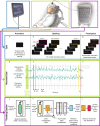Generalizable spelling using a speech neuroprosthesis in an individual with severe limb and vocal paralysis
- PMID: 36347863
- PMCID: PMC9643551
- DOI: 10.1038/s41467-022-33611-3
Generalizable spelling using a speech neuroprosthesis in an individual with severe limb and vocal paralysis
Abstract
Neuroprostheses have the potential to restore communication to people who cannot speak or type due to paralysis. However, it is unclear if silent attempts to speak can be used to control a communication neuroprosthesis. Here, we translated direct cortical signals in a clinical-trial participant (ClinicalTrials.gov; NCT03698149) with severe limb and vocal-tract paralysis into single letters to spell out full sentences in real time. We used deep-learning and language-modeling techniques to decode letter sequences as the participant attempted to silently spell using code words that represented the 26 English letters (e.g. "alpha" for "a"). We leveraged broad electrode coverage beyond speech-motor cortex to include supplemental control signals from hand cortex and complementary information from low- and high-frequency signal components to improve decoding accuracy. We decoded sentences using words from a 1,152-word vocabulary at a median character error rate of 6.13% and speed of 29.4 characters per minute. In offline simulations, we showed that our approach generalized to large vocabularies containing over 9,000 words (median character error rate of 8.23%). These results illustrate the clinical viability of a silently controlled speech neuroprosthesis to generate sentences from a large vocabulary through a spelling-based approach, complementing previous demonstrations of direct full-word decoding.
© 2022. The Author(s).
Conflict of interest statement
S.L.M., J.R.L., D.A.M., and E.F.C. are inventors on a pending provisional patent application that is directly relevant to the neural-decoding approach used in this work. G.K.A and E.F.C are inventors on patent application PCT/US2020/028926, D.A.M. and E.F.C. are inventors on patent application PCT/US2020/043706 and E.F.C. is an inventor on patent US9905239B2 which are broadly relevant to the neural-decoding approach in this work. The remaining authors declare no competing interests.
Figures







